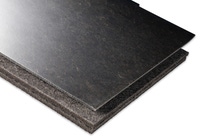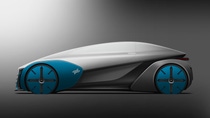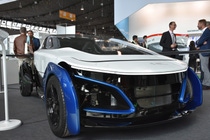Media
BASF and BNP Brinkmann acting as project partners to support current DLR research on the future of mobility
- Use of light-weight, natural-fiber composite produced with Acrodur® binder for DLR’s “Next Generation Car” (NGC) research project
- Presentation of NGC vehicle prototype at Composites Europe taking place in Stuttgart from September 10 to 12
As the second largest, institutionally funded transport research institution in Europe, the German Aerospace Center (Deutsches Zentrum für Luft- and Raumfahrt/DLR) uses its transport program to address the big questions involving the future of mobility. BASF and its partner BNP Brinkmann are supporting the current research project “Next Generation Car” with a tailormade, light-weight composite based on natural fiber. “By using our Acrodur binder we were able, together with our partner BNP Brinkmann, to produce a composite material from renewable resources that meets the German Aerospace Center’s particularly high requirements for stability and weight”, explains Thorsten Habeck, Head of Business Management Fiber Bonding – Europe, Middle East & Africa at BASF.
Light-weight construction – the key to future vehicle concepts
The goal of the German Aerospace Center’s project “Next Generation Car (NGC)” is to promote the development of quiet, low-emission road vehicles with a high degree of automation and a wide range. It uses state-of-the-art technologies, among other things, for vehicle structure, engine and energy management. Light-weight construction is key when it comes to the development of innovative vehicle concepts: About two thirds of fuel consumption depend directly on the weight of the vehicle.
The contribution to the project made by BASF and its partner BNP Brinkmann concerned the “Safe Light Regional Vehicle” (SLRV), the smallest and lightest of the vehicle concepts developed as part of the NGC project. It combines a novel, metal sandwich type of construction with an innovative entry concept, a highly efficient hydrogen fuel cell engine and a novel car body to meet the demanding safety and weight (450 kg) requirements of the light-weight L7 vehicle category. The German Aerospace Center is going to give the public a first glimpse by presenting a prototype of the NGC SLRV at the Composites Europe trade fair that will take place in Stuttgart from September 10 to 12.
Acrodur-based, natural fiber composite to protect the car body
The interior floor of the NGC SLRV features light-weight composites made from natural fiber to protect the car body against mechanical deformation. “BASF and BNP Brinkmann were able to help us meet a difficult requirement and supplied us with tailormade molded parts that combine extremely low weight with high stability. This was essential for our NGC SLRV because, as the hood opens upward, people get into the car in an upright position, which leads to a particularly high point load on the car body in the footwell”, explains Michael Kriescher, responsible project leader at the Institute for Vehicle Concepts of the German Aerospace Center.
BASF helped produce the component by providing its experience with fiber bonding products. In the past, this expertise and the use of the Acrodur binder for natural fiber composites led to several high-performance light-weight components that were serially produced for the automotive industry.
Collaboration partner BNP Brinkmann, a specialist for multifaceted types of fleece that are used for semi-finished products by the automotive industry, supported the production of the component. “When we develop innovative technical fleece fabrics, we are, as far as mobility is concerned, apart from light-weight, absorption and insulation solutions, particularly focusing on products made from renewable raw materials. Our experience and the particular characteristics of the Acrodur binder enabled us to produce the highly effective composite required by the German Aerospace Center by almost exclusively using natural fibers”, says Thomas Güthe, Managing Director of BNP Brinkmann.
More information about the “Next Generation Car” project of the German Aerospace Center can be found at https://verkehrsforschung.dlr.de/de/verkehrsforschung/strassenfahrzeuge/fahrzeugkonzepte
More information about the NGC Safe Light Regional Vehicle can be found at https://verkehrsforschung.dlr.de/de/projekte/ngc-slrv
More information about BASF's Acrodur binder can be found at this website.
More information about BNP Brinkmann can be found at https://www.bnp-brinkmann.de
More information about Composites Europe 2019 can be found at https://www.composites-europe.com
BASF’s Dispersions & Pigments division
The Dispersions & Pigments division of BASF develops, produces and markets a range of high-quality pigments, resins, additives and polymer dispersions worldwide. These raw materials are used in formulations for a number of industries, including coatings, construction, adhesives, printing and packaging, electronics and paper. With its comprehensive product portfolio and its extensive knowledge of the industry, the Dispersions & Pigments division offers its customers innovative and sustainable solutions and helps them advance their formulations. For further information about the Dispersions & Pigments division, please visit www.dispersions-pigments.basf.com.
About BASF
At BASF, we create chemistry for a sustainable future. We combine economic success with environmental protection and social responsibility. The approximately 122,000 employees in the BASF Group work on contributing to the success of our customers in nearly all sectors and almost every country in the world. Our portfolio is organized into six segments: Chemicals, Materials, Industrial Solutions, Surface Technologies, Nutrition & Care and Agricultural Solutions. BASF generated sales of around €63 billion in 2018. BASF shares are traded on the stock exchange in Frankfurt (BAS) and as American Depositary Receipts (BASFY) in the U.S. Further information at www.basf.com.
P-19-328



